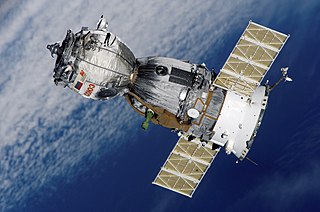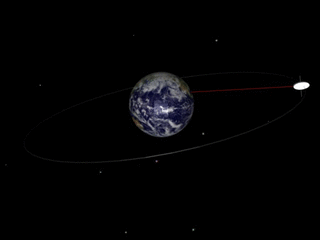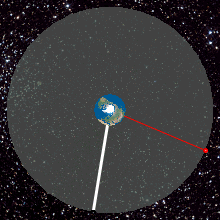Related Research Articles

Ariane 5 is a retired European heavy-lift space launch vehicle operated by Arianespace for the European Space Agency (ESA). It was launched from the Guiana Space Centre (CSG) in French Guiana. It was used to deliver payloads into geostationary transfer orbit (GTO), low Earth orbit (LEO) or further into space. The launch vehicle had a streak of 82 consecutive successful launches between 9 April 2003 and 12 December 2017. Since 2014, Ariane 6, a direct successor system, first launched in 2024.

A spacecraft is a vehicle that is designed to fly and operate in outer space. Spacecraft are used for a variety of purposes, including communications, Earth observation, meteorology, navigation, space colonization, planetary exploration, and transportation of humans and cargo. All spacecraft except single-stage-to-orbit vehicles cannot get into space on their own, and require a launch vehicle.

A geosynchronous orbit is an Earth-centered orbit with an orbital period that matches Earth's rotation on its axis, 23 hours, 56 minutes, and 4 seconds. The synchronization of rotation and orbital period means that, for an observer on Earth's surface, an object in geosynchronous orbit returns to exactly the same position in the sky after a period of one sidereal day. Over the course of a day, the object's position in the sky may remain still or trace out a path, typically in a figure-8 form, whose precise characteristics depend on the orbit's inclination and eccentricity. A circular geosynchronous orbit has a constant altitude of 35,786 km (22,236 mi).

A geostationary orbit, also referred to as a geosynchronous equatorial orbit (GEO), is a circular geosynchronous orbit 35,786 km (22,236 mi) in altitude above Earth's equator, 42,164 km (26,199 mi) in radius from Earth's center, and following the direction of Earth's rotation.

The Guiana Space Centre, also called Europe's Spaceport, is a spaceport to the northwest of Kourou in French Guiana, an overseas region of France in South America. Kourou is located approximately 500 kilometres north of the equator at a latitude of 5°. In operation since 1968, it is a suitable location for a spaceport because of its near equatorial location and open sea to the east and north.

The Automated Transfer Vehicle, originally Ariane Transfer Vehicle or ATV, was an expendable cargo spacecraft developed by the European Space Agency (ESA), used for space cargo transport in 2008–2015. The ATV design was launched to orbit five times, exclusively by the Ariane 5 heavy-lift launch vehicle. It effectively was a larger European counterpart to the Russian Progress cargo spacecraft for carrying upmass to a single destination—the International Space Station (ISS)—but with three times the capacity.

A graveyard orbit, also called a junk orbit or disposal orbit, is an orbit that lies away from common operational orbits. One significant graveyard orbit is a supersynchronous orbit well beyond geosynchronous orbit. Some satellites are moved into such orbits at the end of their operational life to reduce the probability of colliding with operational spacecraft and generating space debris.
The Ride Report is the informal name of the report titled NASA Leadership and America's Future in Space: A Report to the Administrator. In 1986, a task force under the leadership of Sally Ride was asked to formulate a new strategy for NASA. The report was issued in 1987.

The following outline is provided as an overview of and topical guide to space exploration.

Thales Alenia Space is a joint venture between the French technology corporation Thales Group (67%) and Italian defense conglomerate Leonardo (33%). The company is headquartered in Cannes, France.
HYLAS is a British satellite in geostationary orbit. HYLAS, which is an acronym for Highly Adaptable Satellite, is a communications satellite and was launched by the European Ariane 5 launch vehicle from the Guyana Space Centre at Kourou in French Guiana. It is located at the orbital location of 33.5 degrees west and will provide new and innovative services including High Definition Television (HDTV) and interactive satellite delivered broadband services. The satellite will help address the issue of poor broadband coverage in many parts of Europe which have less developed ground infrastructure.

An orbital propellant depot is a cache of propellant that is placed in orbit around Earth or another body to allow spacecraft or the transfer stage of the spacecraft to be fueled in space. It is one of the types of space resource depots that have been proposed for enabling infrastructure-based space exploration. Many depot concepts exist depending on the type of fuel to be supplied, location, or type of depot which may also include a propellant tanker that delivers a single load to a spacecraft at a specified orbital location and then departs. In-space fuel depots are not necessarily located near or at a space station.

Docking and berthing of spacecraft is the joining of two space vehicles. This connection can be temporary, or partially permanent such as for space station modules.
Space Infrastructure Servicing (SIS) is a spacecraft concept being developed by Canadian aerospace firm MDA to operate as a small-scale in-space refueling depot for communication satellites in geosynchronous orbit.
The Mission Extension Vehicle (MEV) is a spacecraft that extends the functional lifetime of another spacecraft through on-orbit satellite servicing. They are 2010s-design small-scale in-space satellite-refueling spacecraft first launched in 2019. The MEV spacecraft grew out of a concept proposed in 2011 by ViviSat, a 50/50 joint venture of aerospace firms US Space and Alliant Techsystems (ATK). The joint venture was created in 2010 for the purpose of designing, producing and operating the MEV program.

A space tug is a type of spacecraft used to transfer spaceborne cargo from one orbit to another orbit with different energy characteristics. The term can include expendable upper stages or spacecraft that are not necessarily a part of their launch vehicle. However, it can also refer to a spacecraft that transports payload already in space to another location in outer space, such as in the Space Transportation System concept. An example would be moving a spacecraft from a low Earth orbit (LEO) to a higher-energy orbit like a geostationary transfer orbit, a lunar transfer, or an escape trajectory.
On-orbit satellite servicing refers to refueling or repairing space satellites while in orbit.
Electra is a satellite development project initiated by the European Space Agency (ESA) as the first partnership project under its ARTES-33 programme. In conjunction with satellite operator SES and satellite builder OHB Systems, the Electra project seeks to develop, launch and validate in orbit an electric-only propulsion platform for geostationary communications satellites of below 3 tonnes launch mass. Electra encompasses both a coordinated effort to develop a European full electric propulsion small geostationary satellite, and the implementation of a mission by SES providing flight heritage and in-orbit demonstration of the platform to gain market acceptance for the product.
Starfish Space is an American satellite company focused on space rendezvous and satellite servicing based in the Seattle metropolitan area. It was founded in 2019 by Austin Link and Dr. Trevor Bennett, both former engineers at Blue Origin. Starfish Space is developing the Otter spacecraft, designed for satellite servicing. The first three Otter vehicles are scheduled for launch in 2026 with missions planned for NASA, U.S. Space Force and Intelsat.
References
- ↑ "ConeXpress project support". ESA. 9 May 2014. Archived from the original on 13 October 2014. Retrieved 8 October 2014.
- ↑ "ConeXpress-Orbital Life Extension Vehicle (CX-OLEV)". ESA. 2010-11-22.
- ↑ "Final Presentation on ConeXpress". ESA. 4 April 2005. Archived from the original on 13 December 2022. Retrieved 12 December 2022.